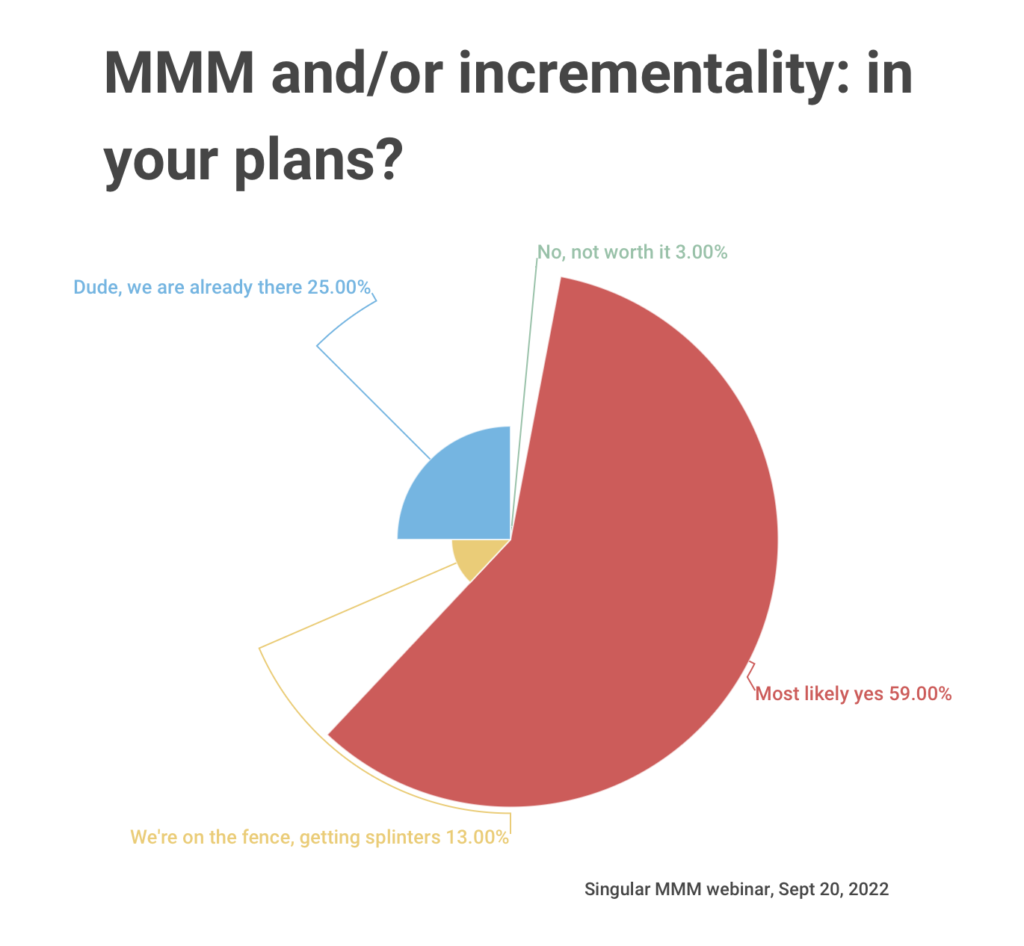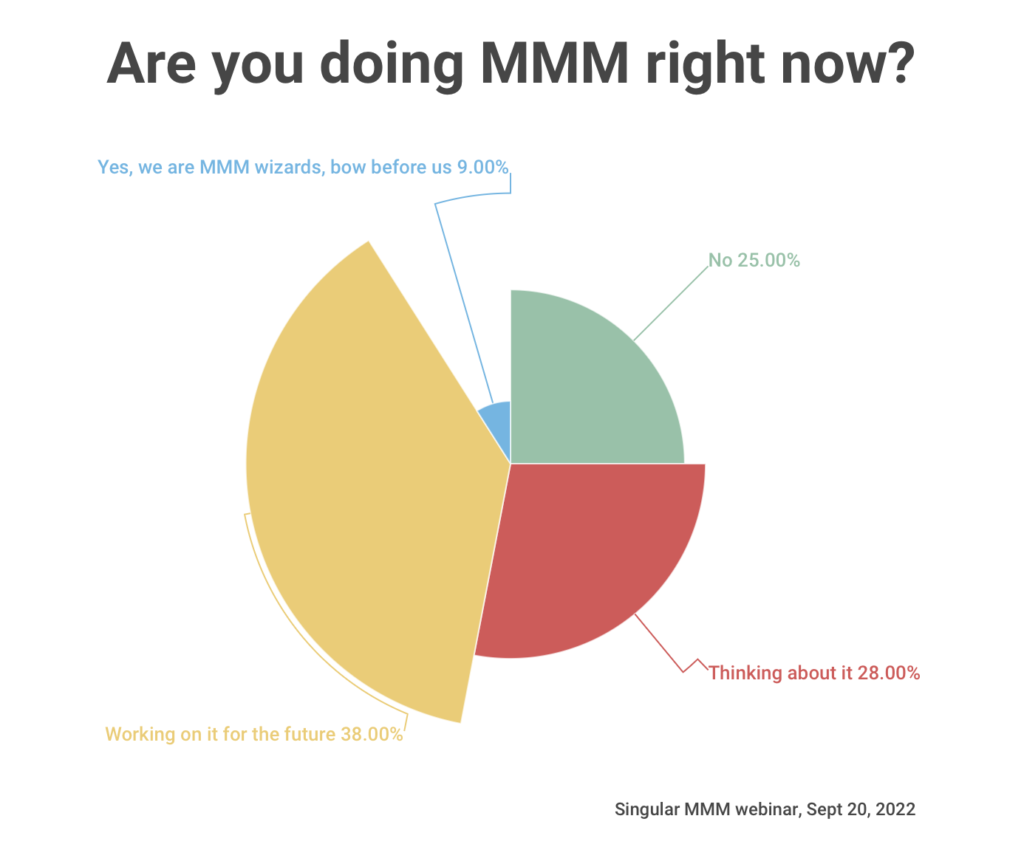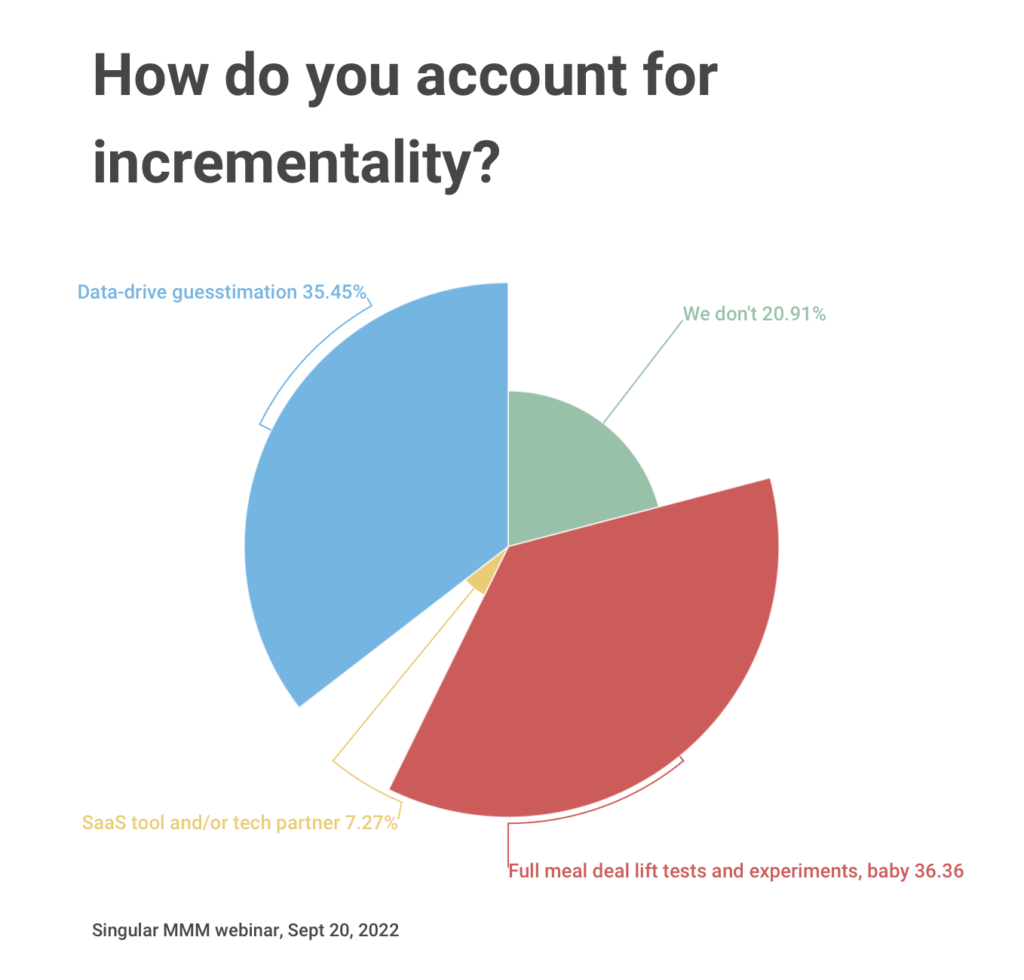Live poll: 97% of mobile marketers are doing, planning, or considering media mix modeling and/or incrementality right now
The landscape of marketing measurement in mobile user acquisition is drastically changing. We are literally seeing seismic shifts in how mobile marketers think about marketing analytics and measuring advertising effectiveness.
One example: if you can trust the results of a poll during our recent webinar on Media Mix Modeling, almost every mobile marketer is either doing MMM, planning to do MMM, or considering how to implement MMM in the near future.

I want to say “mind blown,” but perhaps it shouldn’t be.
Here’s the sense in which that’s shocking, however. We are literally not much more than a year away from a time in which last-click deterministic attribution was the absolute unquestioned norm across the entire industry, and while flawed it was good enough to power massive and efficient growth.
Moving from that to a probabilistic model that is notoriously tricky to get right and even in best-case scenarios more than a little hazy on the finer details of performance is surprising.
Now, there are lots of caveats here, so don’t get too excited. One, it was a webinar on media mix modeling, so there’s very obviously a self-selected audience. Two, while Singular typically has well over 1,000 registrants for webinars, only about 30% of people attend live and can therefore vote in a live poll. Three, we gave people about 60 seconds to make a choice.
However, with all those caveats, I’m still surprised. Only 3% of marketers said they were not considering media mix modeling — or marketing mix modeling as panelist Igor Skokan from Meta reminded us — and not considering using incrementality either.
Media mix modeling: 75% of mobile marketers are buying in
If we dial right into MMM alone, leaving incrementality out of the picture, almost 10% of marketers said they were doing MMM right now. A quarter said they would not consider doing media mix modeling, but but a full 75% of mobile marketers are either doing MMM, working on MMM, or thinking about using MMM to measure marketing results.

Looking at those numbers, there’s clearly a massive market opportunity in providing solutions for MMM, especially if you can do so without forcing marketers into complex and time-consuming forays deep into data science.
Incrementality: 56% of marketers are kinda winging it
Incrementality is an interesting case.
It’s a way, of course, of checking whether any given marketing channel or advertising partner is providing results that would not otherwise have occurred if you hadn’t used it at all. As such, it’s an important marketing measuring rod for channel or partner effectiveness, and for justifying spend. It has been for decades, and it’s something that doesn’t require huge amounts of data science sophistication, either.
But it does require some discipline. And some commitment, because to do successful tests you either have to pause other activities or generate enough intentional variation in channel/partner activity that you can tease out the results of each one.
A majority of marketers, however, are either not doing incrementality at all — just over 20% — or just kinda guessing: 35%.

That said, over a third said they were doing actual lift tests and experiments, which is a fairly high-level incrementality measurement. And just over 7% said they actually used a SaaS tool or a data partner to run incrementality testing.
Question: will SKAN 4 and Privacy Sandbox for Android change any of this?
The reality is that measurability on iOS has been so bad for so many mobile marketers that they’re desperate for almost anything else. (Note: despite the fact that Singular customers get 50% more SKAN data via mixed models, massively boost visible performance via modeling, and essentially get cohorts back with Singular’s advanced SKAN analytics.)
And it’s not just iOS.
About half a year ago, Google said that the GAID will be phased out within two years. Given what we’ve seen with the third-party cookie — and, let’s be honest, ATT and SKAdNetwork too — that may slide. But the Google Ad ID is definitely on life support.
There’s a big question mark here, however.
On the one hand, will SKAN 4, which provides more data, offers much more insight on what happens after the initial install with 3 potential postbacks, and provides more IDs in the source identifier for creative and other variable optimization, change growth marketers’ perceptions on iOS? And on the other hand, will Privacy Sandbox for Android, with on-device targeting in TOPICS and built-in retargeting in FLEDGE, be enough to entice marketers back from MMM?
I think not.
I think the ship has sailed, and having lost the IDFA and GAID and deterministic granular data, marketers are going to take what they can get from the platforms in SKAN and Privacy Sandbox, but augment and supplement that with media mix modeling and other sources of marketing measurement. Doing so will make marketers less dependent on doled-out platform data and single sources of potentially biased information and more aware of external factors affecting performance.
In short, I think the future is hybrid measurement: data from all possible sources combined to provide an overview of performance and used individually for what each measurement methodology is best at.
And what that means is using all of spend, delivery data (impressions, clicks, etc.), SKAN, IDFA where possible, GAID now, Privacy Sandbox for Android and Web in the future, revenue, first-party data, and even ecosystem data all together … plus anything else that makes sense to add to the mix.
Which means media mix modeling has a strong future in mobile marketing.
And that’s fairly amusing if you think about it: 3 years ago almost no one in the industry would have ever believed it.
Stay up to date on the latest happenings in digital marketing


